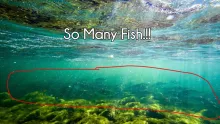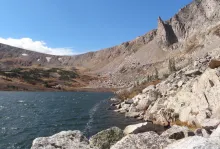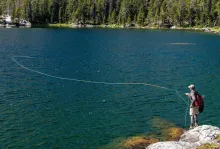This is a great book, and a really excellent intro to reading the water and matching the hatch for the angler who feels that both these disciplines are difficult. It clearly illustrates that they don't have to be.
Updated or edited 4 months ago
When I started out fly fishing, I remember ever so often bumping into books and articles that would have the term ”reading the water” in the title or as a chapter heading. It would be illustrated with drawings of a stream seen from above, and fish symbols would be drawn in different numbers, sizes and colors, indicating where in this make believe mass of water a fish would dwell, ready to take your fly.
I studied these illustrations, memorizing the different holding spots. Fall, eddy, seam, froth line, backwater, neck, freestone, rapids, undercut banks and all the features of the stream memorized.
Out in the real world I saw none of these features. My first meetings with running water were confusing to say the least.
On a typical Danish stream I'd see a basically smooth, slow moving surface with no significant features, and on more rapid streams in mountainous regions of the world, I saw a mass of water moving fast, so full of complex structures I couldn't rest my eyes on one.
I was really lousy at finding the lies, covering them with a fly or spotting fish and casting to them without spooking fish far closer or simply totally misjudging the speed and nature of the water, leading to streaming flies, and no takes.
When I started reading Philip White's book Observation, the first thing I expected was to see similar illustrations, which I - even after all my fishing years - still find to be a crude simplification compared to being out there, looking.
I didn't find any in White's book. In spite of the title, they aren't there. I consider that a good thing.
In stead White leads the reader through a series of chapters, which aim to teach the art of observation. Observing fish behavior and rise forms. Observing stream and lake topography. Observing insect life, hatches and what and how the fish eat.
This is much more in line with how I actually started learning to fish streams: being out there, watching and using what you see as a lead.
White's approach is actually really simple. Good simple and not crude simple as the above mentioned drawings. He basically covers the ground in about 40 pages, not teaching you how to read the water. But teaching you how to learn to read the water. There's a difference there, and a huge one. White expects you to take the general knowledge and methods he lines up, and then go out into the wild and learn the details yourself.
Being British, he covers lakes as much as he covers streams, so some stream only anglers might get some knowledge they won't use every day. Still a lot of the observational tools are the same, no matter whether you fish still or running water.
White covers the different quarries: flying insects in different stages, nymphs, terrestrials etc. and he urges you to use a pragmatic approach, not learning Latin names, but learning basic shapes: shrimps, lice, beetles, upwings, sedges and so on. Simple categories that will let you pick the proper fly based on shape, size and color of the naturals combined with the feeding pattern you see in the fish you are targeting.
From that he goes on into fly tying, and the remaining 130 pages of the book is an introduction to some really simple and efficient looking patterns, tied to meet the criteria your observations have given you.
Each pattern is shown, described and accompanied by a step-by-step series of photos. The flies are quite generic and have names as Shrimp, Swimming Dragonfly Nymph and Mating Hawthornes. Each group is introduced shortly with a small chapter on its natural history, helping you understand the life cycle and stages of the natural.
The flies are quite generic and have names as Shrimp, Swimming Dragonfly Nymph and Mating Hawthornes.
So, as you can see from the sheer number of pages dedicated to each subject, the book is as much a pattern book as it is a lecture in reading the water.
And it does a really good job of both, simplifying the subjects in a way that make them very easy to understand, with instructions that are very easy to follow, full of nice photos that clarify the points.
If I had had a book like this before I ventured out on a stream for the first time, I'd probably have been a lot less confused and a lot more self confident. Maybe I'd even have caught more fish.
This is a great book, and a really excellent intro to reading the water and matching the hatch for the angler who feels that both these disciplines are difficult. It clearly illustrates that they don't have to be.
- Log in to post comments







